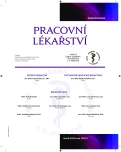Analysis of the nurses working load at the orthopaedics-traumatology department
Authors:
M. Loskotová; K. Veverková; R. Košťál; V. Džupa
Authors‘ workplace:
Ortopedicko-traumatologická klinika 3. LF UK a FNKV, Praha, přednosta prof. MUDr. Martin Krbec, CSc.
Published in:
Pracov. Lék., 67, 2015, No. 1, s. 6-11.
Category:
Original Papers
Overview
The aim of the study was to analyse the working load of nurses at various units of orthopaedics-traumatology department.
The study was carried out as a questionnaire survey. Forty nurses of five units participated in the survey (intensive care unit, septic orthopaedics unit, traumatology unit, elective orthopaedics unit, early postoperative rehabilitation unit), eight nurses of each unit, two in day duty and two in night duty, in a week day (Thursday) and in a weekend day (Saturday) of the same week.
The major time during the day, night and weekend, duty was dedicated to the nursing care (7–21%), patients needs responses (7–24%) and giving medicines (11–28%) with obvious differences in the studied parameters in different units. The septic unit had the longest time for wound dressing (9% of day duty time), the elective unit had the longest time for administrative work (23% of night duty time). The vital functions monitoring consumed the shortest time at the intensive care unit due to automatic monitoring of pulse rate and blood pressure. The differences were seen when comparing day and night duties as well as comparing week and weekend days.
The study results showed that the profile of the orthopaedic and traumatology hospital unit influences the time dedicated to various types of nursing work.
Keywords:
working load – types of nursing care
Sources
1. Aiken, L. H., Clarke, S. P., Sloane, D. M., Sochalski, J. A., Busse, R., Clarke, H. et al. Nurses‘ reports on hospital care in five countries. Health Affairs, 2001, 20, s. 43–53.
2. Jarošová, D. Teorie moderního ošetřovatelství. Praha: Management press 2000.
3. Závodná, V. Pedagogika v ošetrovateľstve. Martin : Osveta 2006.
4. Bartošíková, I. O syndromu vyhoření pro zdravotní sestry. Národní centrum ošetřovatelství a nelékařských zdravotnických oborů, Brno, 2006.
5. Veverková, K. Zjišťování rozdílu v intenzitě únavy u sester interních a chirurgických oborů v pražské fakultní nemocnici. Národní centrum ošetřovatelství a nelékařských zdravotnických oborů, Brno, 2007.
6. Graf, C. M., Millar, S., Feiteau, C., Coakley, P. J., Erickson, J. I. Patients‘ needs for nursing care: Beyond staffing ratios. J. Nurs Admin., 2003, 33, s. 76–81.
7. Kane, R. L., Shamliyan, T. A., Mueller, C., Duval, S., Wilt, T. J. The association of registered nurse staffing levels and patient outcomes: systematic review and meta-analysis. Medical Care, 2007, 45, s. 1195–1204.
8. Needleman, J., Buerhaus, P. I., Mattke, S., Stewart, M., Zelevinsky, K. Nurse-staffing levels and the quality of care in hospitals. NEJM, 2002, 346, s. 1715–1722.
Labels
Hygiene and epidemiology Hyperbaric medicine Occupational medicineArticle was published in
Occupational Medicine

2015 Issue 1
Most read in this issue
- Nanoparticles from welding and their effects on health
- Psychical work safety
- Risk of the dust containing silica in coal miners – a review
- Analysis of the nurses working load at the orthopaedics-traumatology department
